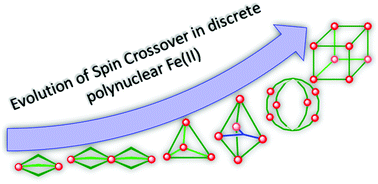当前位置:
X-MOL 学术
›
Chem. Soc. Rev.
›
论文详情
Our official English website, www.x-mol.net, welcomes your
feedback! (Note: you will need to create a separate account there.)
Spin crossover in discrete polynuclear iron(ii) complexes†
Chemical Society Reviews ( IF 40.4 ) Pub Date : 2018-08-20 00:00:00 , DOI: 10.1039/c7cs00835j Ross W. Hogue 1, 2, 3, 4 , Sandhya Singh 1, 2, 3, 4 , Sally Brooker 1, 2, 3, 4
Chemical Society Reviews ( IF 40.4 ) Pub Date : 2018-08-20 00:00:00 , DOI: 10.1039/c7cs00835j Ross W. Hogue 1, 2, 3, 4 , Sandhya Singh 1, 2, 3, 4 , Sally Brooker 1, 2, 3, 4
Affiliation

|
Iron(II) spin crossover (SCO) materials have been widely studied as molecular switches with a wide variety of potential applications, including as displays, sensors, actuators or memory components. Most SCO materials have been either monometallic or polymeric, and it is only relatively recently that chemists have really started to focus on linking multiple metal centres together within the one, discrete, molecule in an effort to enhance the SCO properties, such as abrupt, hysteretic, and multistep switching, as well as the potential for quantum cellular automata, whilst still being readily amenable to characterisation. Here we present a review of the ligand designs of the last two decades that have led to self assembly of discrete di- to poly-nuclear iron(II) complexes of helicate, cage, cube, and other supramolecular architectures with rich SCO activity, and to an increased focus on host–guest interactions. Analysis of selected octahedral distortion parameters (Σ, CShM) reveals interesting differences between these structural types, for example that the iron(II) centres in grids are generally significantly more distorted than those in squares or cages, yet are still SCO-active. Of the 127 complexes reviewed (79 published 2012–Feb. 2018), 54% are dinuclear, 10% trinuclear, 31% tetranuclear, and the remaining 5% are penta, hexa and octanuclear. Of the 93 designer ligands utilised in these polynuclear architectures: 60 feature azoles; 55 provide all donors to the Fe(II) centres (no co-ligands coordinated) and form exclusively 5-membered chelate rings via either bidentate azole-imine/pyridine or tridentate heterocycle-imine/amine/thioether/pyridine-heterocycle binding pockets.
中文翻译:

离散多核铁(ii)配合物中的自旋交叉†
铁(II)自旋交越(SCO)材料已被广泛研究为具有多种潜在应用的分子开关,包括显示器,传感器,致动器或存储组件。大多数SCO材料要么是单金属材料,要么是聚合材料,直到最近,化学家才真正开始集中精力将一个离散的分子内的多个金属中心连接在一起,以增强SCO特性,例如突变,滞后性。 ,多步切换以及量子细胞自动机的潜力,同时仍然很容易进行表征。在这里,我们对过去二十年的配体设计进行了综述,这些配体设计导致了离散的二核到多核铁的自我组装(II)具有丰富SCO活性的螺旋状,笼状,立方体状和其他超分子结构的复合物,并且越来越关注宿主与客体之间的相互作用。对选定的八面体变形参数(Σ,CShM)的分析揭示了这些结构类型之间的有趣差异,例如,网格中的铁(II)中心通常比正方形或笼子中的铁(II)中心失真更大,但仍然具有SCO活性。在审查的127种复合物中(79种于2012年2月至2018年2月出版),双核为54%,三核为10%,四核为31%,其余为penta,hexa和octanuclear。在这些多核结构中使用的93种设计配体中:60种为功能唑。55提供的所有捐款人的Fe(II)中心(无共配体配位),并通过二齿吡咯亚胺/吡啶或三齿杂环-亚胺/胺/硫醚/吡啶-杂环结合口袋形成5元螯合环。
更新日期:2018-08-20
中文翻译:

离散多核铁(ii)配合物中的自旋交叉†
铁(II)自旋交越(SCO)材料已被广泛研究为具有多种潜在应用的分子开关,包括显示器,传感器,致动器或存储组件。大多数SCO材料要么是单金属材料,要么是聚合材料,直到最近,化学家才真正开始集中精力将一个离散的分子内的多个金属中心连接在一起,以增强SCO特性,例如突变,滞后性。 ,多步切换以及量子细胞自动机的潜力,同时仍然很容易进行表征。在这里,我们对过去二十年的配体设计进行了综述,这些配体设计导致了离散的二核到多核铁的自我组装(II)具有丰富SCO活性的螺旋状,笼状,立方体状和其他超分子结构的复合物,并且越来越关注宿主与客体之间的相互作用。对选定的八面体变形参数(Σ,CShM)的分析揭示了这些结构类型之间的有趣差异,例如,网格中的铁(II)中心通常比正方形或笼子中的铁(II)中心失真更大,但仍然具有SCO活性。在审查的127种复合物中(79种于2012年2月至2018年2月出版),双核为54%,三核为10%,四核为31%,其余为penta,hexa和octanuclear。在这些多核结构中使用的93种设计配体中:60种为功能唑。55提供的所有捐款人的Fe(II)中心(无共配体配位),并通过二齿吡咯亚胺/吡啶或三齿杂环-亚胺/胺/硫醚/吡啶-杂环结合口袋形成5元螯合环。









































 京公网安备 11010802027423号
京公网安备 11010802027423号